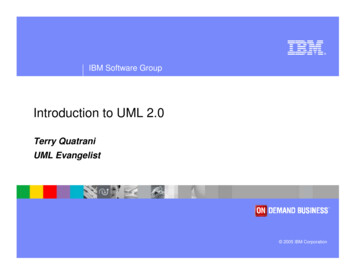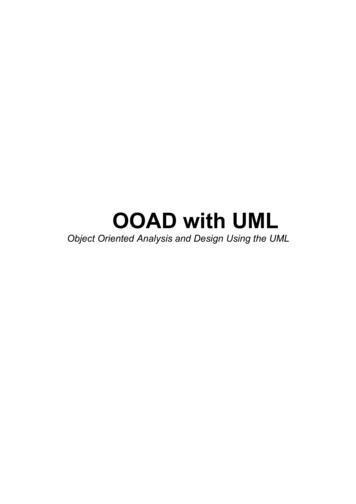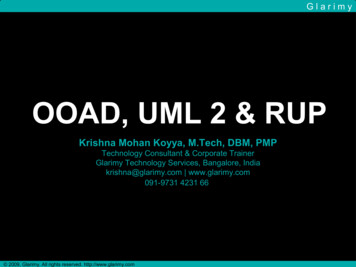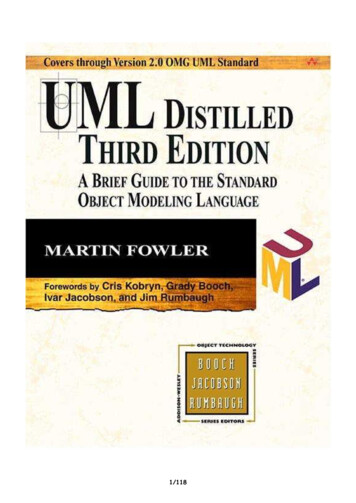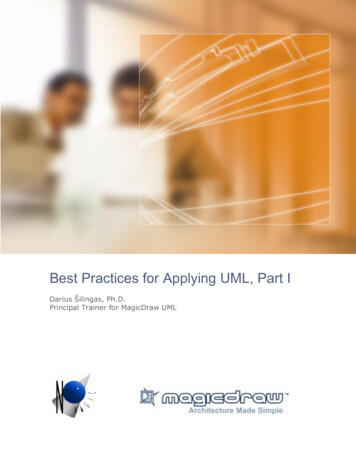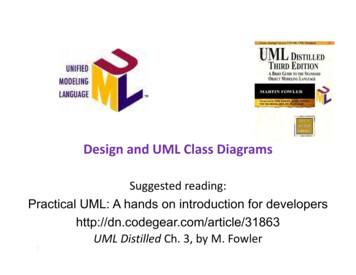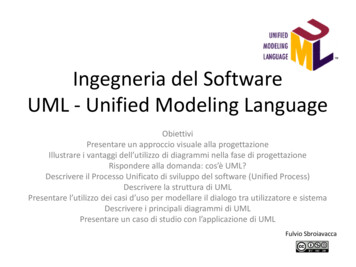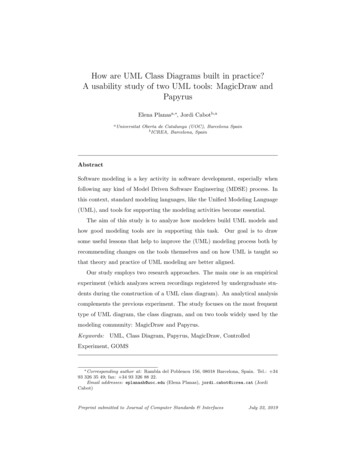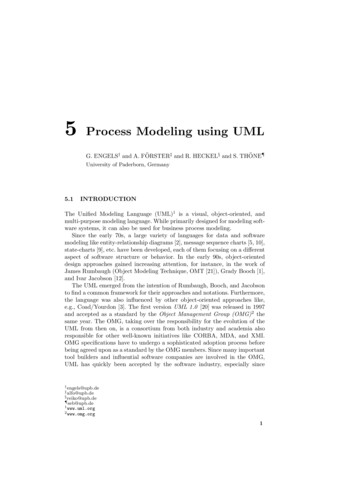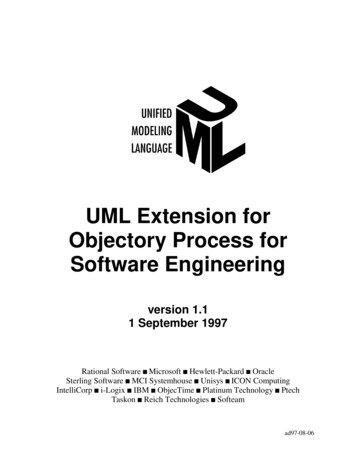
Transcription
UML Extension forObjectory Process forSoftware Engineeringversion 1.11 September 1997Rational Software Microsoft Hewlett-Packard OracleSterling Software MCI Systemhouse Unisys ICON ComputingIntelliCorp i-Logix IBM ObjecTime Platinum Technology PtechTaskon Reich Technologies Softeamad97-08-06
Copyright 1997 Rational Software Corporation.Copyright 1997 Microsoft Corporation.Copyright 1997 Hewlett-Packard Company.Copyright 1997 Oracle Corporation.Copyright 1997 Sterling Software.Copyright 1997 MCI Systemhouse Corporation.Copyright 1997 Unisys Corporation.Copyright 1997 ICON Computing.Copyright 1997 IntelliCorp.Copyright 1997 i-Logix.Copyright 1997 IBM Corporation.Copyright 1997 ObjecTime Limited.Copyright 1997 Platinum Technology Inc.Copyright 1997 Ptech Inc.Copyright 1997 Taskon A/S.Copyright 1997 Reich Technologies.Copyright 1997 Softeam.Photocopying, electronic distribution, or foreign-language translation of this document ispermitted, provided this document is reproduced in its entirety and accompanied with this entirenotice, including the following statement:The most recent updates on the Unified Modeling Language are available via theworldwide web, www.rational.com/uml.Objectory and the UML logo are trademarks of Rational Software Corp.OMG, CORBA, CORBAfacility, and IDL are trademarks of the Object Management Group, Inc.iiUML Extension for the Objectory Process, v1.1
Contents1.INTRODUCTION2.SUMMARY OF EXTENSION12.1 Stereotypes.12.2 TaggedValues .12.3 Constraints .12.4 Prerequisite Extensions .23.2STEREOTYPES AND NOTATION3.1 Model, Package, and Subsystem Stereotypes .23.1.1 Use Case.23.1.2 Analysis.23.1.3 Design .23.1.4 Implementation.33.1.5 Notation.33.2 Class Stereotypes .43.2.1 Entity .43.2.2 Control.43.2.3 Boundary .43.2.4 Notation.43.3 Association Stereotypes .43.3.1 Communicates.53.3.2 Subscribes .53.3.3 Notation.54.5WELL-FORMEDNESS RULES4.1 Generalization .54.2 Association.5UML Extension for the Objectory Process, v1.11iii
1. INTRODUCTIONThis document defines the UML Extension for Objectory Process for Software Engineering,defined in terms of the UML’s extension mechanisms, namely Stereotypes, TaggedValues, andConstraints.See the UML Semantics document for a full description of the UML extension mechanisms.This document is not meant to be a complete definition of the Objectory process and how toapply it, but it serves the purpose of registering this extension, including its icons.2. SUMMARY OF EXTENSION2.1 STEREOTYPESMetamodel orationStereotype Nameuse case modelanalysis modeldesign modelimplementation modeluse case systemanalysis systemdesign systemimplementation systemanalysis subsystemdesign subsystemimplementation subsystemuse case packageanalysis service packagedesign service use case realization2.2 TAGGEDVALUESThis extension does not currently introduce any new TaggedValues.2.3 CONSTRAINTSThis extension does not currently introduce any new Constraints, other than those associated withthe well-formedness semantics of the stereotypes introduced.UML Extension for the Objectory Process, v1.11
2.4 PREREQUISITE EXTENSIONSThis extension requires no other extensions to the UML for its definition.3. STEREOTYPES AND NOTATION3.1 MODEL, PACKAGE, AND SUBSYSTEM STEREOTYPESAn Objectory system comprises several different but related models. Objectory models arecharacterized by the lifecycle stage that they represent. The different models are stereotypes ofmodel: Use CaseAnalysisDesignImplementation3.1.1 Use CaseA Use Case Model is a model in which the top-level package is a use case system.A Use Case System is a top-level package. A use case system contains use case packages and/oruse cases and/or actors and relationships.A Use Case Package is a package containing use cases and actors with relationships. A use caseis not partitioned over several use case packages.3.1.2 AnalysisAn Analysis Model is a model whose top-level package is an analysis system.An Analysis System is a top-level subsystem. An analysis system contains analysis subsystemsand/or analysis service packages and/or analysis classes (i.e. entity, boundary, and control) andrelationships.An Analysis Subsystem is a subsystem containing other analysis subsystems, analysis servicepackages, analysis classes (i.e. entity, boundary, and control), and relationships.An Analysis Service Package is a subsystem containing analysis classes (i.e. entity, boundary,and control) and relationships.3.1.3 DesignA Design Model is a model whose top-level package is a design system.A Design System is a top-level subsystem. A design system contains design subsystems and/ordesign service packages and/or design classes and relationships.2UML Extension for the Objectory Process, v1.1
A Design Subsystem is a subsystem containing other design subsystems, design service packages,design classes, and relationships.A Design Service Package is a subsystem containing design classes and relationships.3.1.4 ImplementationAn Implementation Model is a model whose top-level package is an implementation system.An Implementation System is a top-level package. An implementation system containsimplementation subsystems and/or components and relationships.An Implementation Subsystem is a package containing implementation subsystems and/orcomponents and relationships.3.1.5 NotationPackage stereotypes are indicated with stereotype keywords in guillemets («stereotype name»).There are no stereotyped icons for packages.«use case system»OrderingCheck StatusSalespersonPlace OrderFill rFigure 1. Objectory packagesUML Extension for the Objectory Process, v1.13
3.2 CLASS STEREOTYPESAnalysis classes come in the following three kinds (design classes are not stereotyped in theObjectory process):3.2.1 EntityEntity is a class that is passive; that is, it does not initiate interactions on its own. An entity objectmay participate in many different use case realizations and usually outlives any single interaction.3.2.2 ControlControl is a class, an object of which denotes an entity that controls interactions between acollection of objects. A control class usually has behavior specific for one use case and a controlobject usually does not outlive the use case realizations in which it participates.3.2.3 BoundaryA Boundary is a class that lies on the periphery of a system but within it. It interacts with actorsoutside the system as well as objects of all three kinds of analysis classes within the system.3.2.4 NotationClass stereotypes can be shown with keywords in guillemets. They can also be shown with thefollowing special tFigure 2. Class stereotypes3.3 ASSOCIATION STEREOTYPESThe following are special Objectory associations between classes:4UML Extension for the Objectory Process, v1.1
3.3.1 CommunicatesCommunicates is an association between actors and use cases denoting that the actor sendsmessages to the use case and/or the use case sends messages to the actor. This may be one-way ortwo-way navigation. The direction of communication is indicated by the navigability of theassociation.3.3.2 SubscribesSubscribes is a association whose source is a class (called the subscriber) and whose target is aclass (called the publisher). The subscriber specifies a set of events. The subscriber is notifiedwhen one of those events occurs in the target.3.3.3 NotationAssociation stereotypes are indicated by keywords in guillemets. There are no special stereotypeicons. The stereotype «communicates» on Actor-Use Case associations may be omitted, since it isthe only kind of relationships between actors and use cases.4. WELL-FORMEDNESS RULESStereotyped model elements are subject to certain constraints in addition to the constraintsimposed on all elements of their kind.4.1 GENERALIZATIONAll the modeling elements in a generalization must be of the same stereotype.4.2 ASSOCIATIONApart from standard UML combinations the following combinations are allowed for eachstereotype:Table 1. Valid association stereotype ycontrolcommunicatesUML Extension for the Objectory Process, mmunicatessubscribescommunicatescommunicates5
ad97-08-06 UML Extension for Objectory Process for Software Engineering version 1.1 1 September 1997 Rational Software Microsoft Hewlett-Packard Oracle Sterling Software MCI Systemhouse Unisys ICON Computing IntelliCorp i-Logix IBM ObjecTime Platinum Technology Ptech Taskon Reich Technologies Softeam
